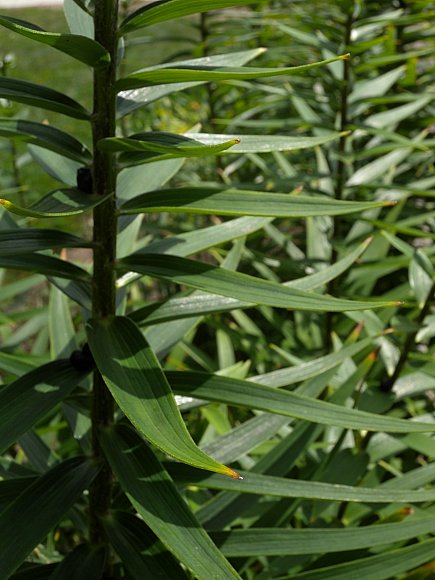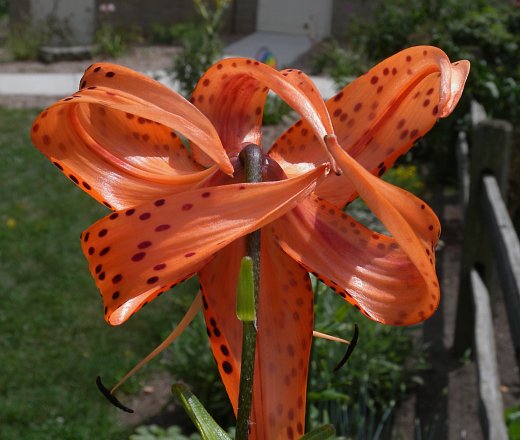
Each flower consists of 6 strongly recurved tepals that are orange to orange-red (forming a funnelform corolla that is turned inside out), 6 strongly exerted stamens, a strongly exerted style with a tripartite stigma, and an ovary. The tepals are narrowly lanceolate and they have dark purple or maroon spots throughout their anterior (frontal) sides. The tips of the tepals bend backward toward the base of the corolla or a little behind the corolla. The style and filaments of the stamens are whitish orange and filiform. The anthers are long, narrow, and dark-colored; their pollen is rust-colored. The blooming period occurs during mid- to late summer, lasting about 1-1½ months. Individual flowers are short-lived, but they are produced in succession. There is little or no floral scent. Because most cultivated and naturalized plants in North America are sterile triploids, usually no seed capsules are produced. When such capsules occur on fertile plants, they are ovoid-oblongoid in shape, glabrous, about 1-1½" in length, and 3-celled; each cell contains 2 columns of seeds. The root system has a globoid or subgloboid bulb consisting of appressed scales; it is 1-3" across with fibrous roots underneath. Sometimes clonal offsets are produced through division of the underground bulb. Clonal plants are sometimes created when the aerial bulblets detach from the mother plant and develop fibrous roots in the ground.

Cultivation: The preference is full or partial sun, moist to dry-mesic conditions, and fertile soil containing loam. This plant is winter-hardy to at least Zone 4 and it is easy to cultivate. Many different cultivars are available. Propagation of new plants can be accomplished by division of the scaly underground bulb once it becomes sufficiently large, or by sowing the aerial bulblets in the ground.
Range & Habitat: Naturalized plants of the Tiger Lily are widely scattered across Illinois, where they are relatively uncommon (see Distribution Map). This species was introduced into North America from East Asia as an ornamental garden plant. It is still widely cultivated for its attractive flowers. Naturalized habitats include cemetery prairies, savannas, thickets, abandoned homestead sites, vacant lots in urban areas, roadsides, and areas along railroads. Naturalized plants can persist at a site for many years unless they are deliberately removed.

Faunal Associations: Insects that are attracted to the flowers include medium- to large-sized butterflies and Halictid bees. The butterflies suck nectar and can cross-pollinate the flowers (if they are fertile), while the small bees collect pollen and are non-pollinating. Insects that feed destructively on Tiger Lily and other orange-flowered lilies (Lilium spp.) include the Lily Leaf Beetle (Lilioceris lilii), larvae of the Narcissus Bulb Fly (Merodon equestris), the Crescent-Marked Lily Aphid (Aulacorthum circumflexum) and Tulip Bulb Aphid (Dysaphis tulipae), larvae of the Burdock Borer Moth (Papaipema cataphracta) and Golden Borer Moth (Papaipema cerina), and leaf-rolling larvae of the Carrion Flower Moth (Acrolepiopsis incertella). White-tailed Deer sometimes browse on the foliage of these plants, while small rodents occasionally feed on the bulbs.

Photographic Location: A flower garden at Meadowbrook Park in Urbana, Illinois.
Comments: The Tiger Lily is a very popular cultivated plant because it has attractive foliage and flowers. Like the native lilies (Lilium spp.) in Illinois, the Tiger Lily produces large orange flowers. It is easily distinguished from the native lilies by considering the following characteristics: 1) unlike the native lilies, the Tiger Lily never produces whorled leaves, 2) unlike the native lilies, the Tiger Lily produces aerial bulblets at the bases of its upper leaves, and 3) instead of a terminal inflorescence, the Tiger Lily produces flowers individually from the axils of its upper leaves. However, if these upper leaves are regarded as floral bracts, then the Tiger Lily produces it flowers in a raceme, instead of the umbel-like inflorescence that is more typical of the native lilies within the state.